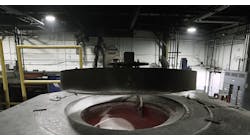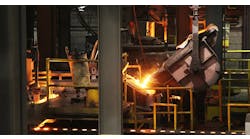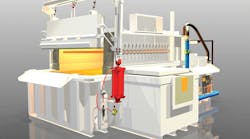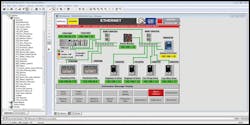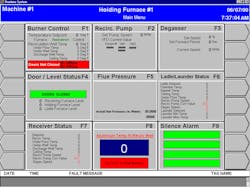The first thing to understand about Industry 4.0 and the related "Smart" factory concept is that this is not a discrete technology, but a combination of advanced technologies that aim to establish smarter, more efficient manufacturing by implementing various technologies that communicate in a way that allows the plant and its constituent processes to run autonomously.
Internet-driven operations receive and exchange huge volumes of data, giving much more control over operations. Businesses use connectivity in many ways, from automatic material ordering to Cloud-based software control. A foundry or diecasting plant can be monitored remotely via cloud-based control systems, giving complete access to the data on the machine and, if needed remote control of certain elements. Using radio-frequency identification (RFID) technologies we are able to automate controls of various machines and processes.
Foundry 4.0 is integration, communication, and usage of data. "Integration" means that everything in a production cell communicates with one location for data storage.
"Communication" means linking process equipment with a computer, to learn when something is about to happen; or, establishing an open channel with a supplier, to "talk" to the equipment, and send daily or weekly reports on what is happening; or, "gathering" data in such a manner to make sure you can use the data.
"Utilization" means applying data to improve a process and monitor its success and failures. All this takes a systems integrator
Systems integrators gather information from process equipment to display data on HMIs and computer screens. They capture data in different formats for storage, and later dissemination, such as trend pressure, temperature, flow, and any other analog input, so customers can track downtimes, maintenance, runtime hours, and waste.
The system integrator uses PLCs to monitor, control, and capture data, including: digital inputs and outputs (AC or DC), limit switches, push buttons, disconnects, pressure switches, lights, horns and more; analog inputs and outputs (mA or volts), thermocouples, pressure transmitters, flow sensors, VFD, RPM, speed, amperage, voltages, and valve position also may be controlled and monitored.
Other items like counters, timers, totalizers using math computing capabilities, along with special control algorithms like PID (closed-loop control), allow customers to have more data to analyze.
Each PLC communicates on a network, usually Ethernet, that connects to an HMI and computers (running SCADA software), and to other PLCs.
Software is used to program each PLC and HMI to monitor and control the process, monitor the network, and share/store the data.
Figure 1 shows an Ethernet network layout: PLC communicating with HMI drives, power monitors, and the SCR drives different colored backgrounds, to indicate status of the network, connected through Ethernet switches.
Supervisory, control, data, and acquisition (SCADA) software gives a metalcasting operation the ability to prove the quality of its castings and head-off issues before they become problems. Area managers can monitor production 24/7. The system can stop production in a workcell if anything is anything out of specification and the data is collected and stored for your protection.
Additional benefits include: lower actual downtime; reduced scrap castings; fewer customer rejects; proof of casting quality; reliable record keeping; proof of the cost of quality; and pinpointing unseen process bottlenecks.
Foundries and diecasters of the future that need to be reactive to the changing market place will have a competitive edge by embracing the Foundry 4.0 concept. They will be more efficient and improve productivity, and at the same time able to be more reactive to customers' needs because these systems will give flexibility, allowing more affordable, short-production runs.
Another benefit will be allowing suppliers access to process equipment, to check the operating conditions. Schaefer Group Inc. can monitor and record data, and even troubleshoot equipment remotely. It is possible to supply a foundry with daily or weekly reports on equipment performance, including up-time, efficiencies, and diagnostics. SGI can monitor bake-out burners from cell phones remotely; install communication systems in a furnace, to monitor, record, and evaluate data every hour of every day over a secure network — and send information to a PLC or cell phone to notify operators of any issues.
Obviously, this is done with a secure, password-protected connection, with security measures in place to prevent hacking. To be a complete Smart foundry or diecaster, you must rely on your Internet connection and upgraded cyber-security systems.
The end result is a factory where customer orders are placed via a centralized control system, and by using integrated Material Requirements Planning/Enterprise Resource Planning (MRP/ERP) software the factory controls its supply chain and production needs automatically.
Machines communicate with each other and the supply chain, placing orders for raw materials and planning production needs to meet lead times. The equipment then works together in the most efficient manner to achieve the customers’ requirements.
This does not mean the end of human involvement, but it does mean metalcasters must put in place workers with a very different skill set. It is important to have an employee able to understand and cope with this advanced technology.
What can you change right now to improve your metalcasting operation? Adopt more automation with communicating abilities. Retrofit existing machines with SCADA system, one cell at a time; plug-and-play systems can be expanded incrementally. Try one cell and see how much you like the control and data acquisition that results. Foundry 4.0 is here, and metalcasters that take advantage of it will be market leaders in a very short time.
David W. White is the national sales manager for The Schaefer Group Inc. Contact him at [email protected]







